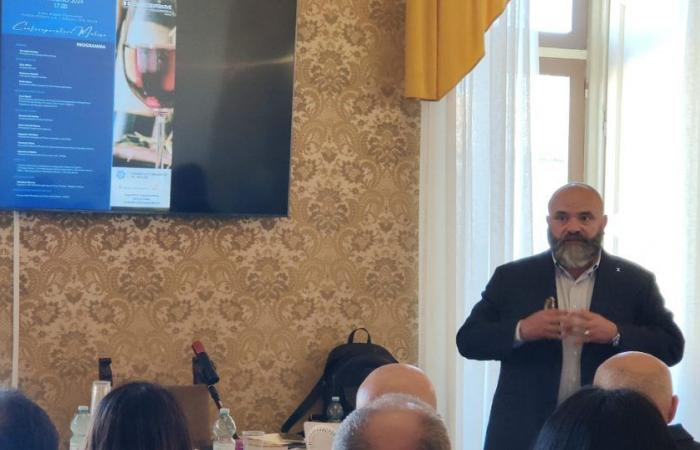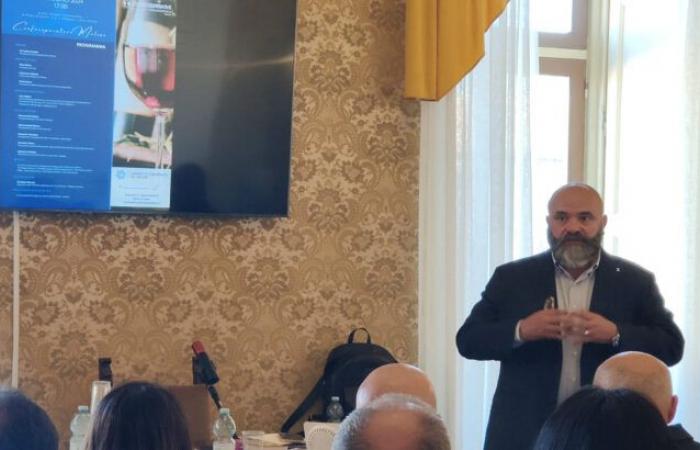CAMPOBASSO – Last Saturday, in Termoli, at the Casa Museo Stephanus, thanks to the collaboration between the Confcooperative Molise Service Center and the Molise Wow cooperative, chaired by Oscar Vetta, the round table entitled “Beyond the crisis: new strategies for Molise red wine” took place.
Social wineries participated (6 out of 10 glasses that arrive on our tables are cooperative), private wineries (Di Majo Norante, but also Borgo di Colloredo, di Remo, Di Vito, Giagnacovo, Catabbo, Cipressi) representatives of institutions, professional organizations, several winemakers, representatives of LAGs and of the three food districts recognized by the Region (Wine, oil and honey).
Special guest Luca Rigotti, president of the Cantina Cooperativa Mezzacorona (over 280 million turnover), president of the Copa Cogeca Wine Group (the most important organization representing the agricultural and agri-food world in Europe) and coordinator of the National Wine Industry Table composed of the Alliance of Agri-food Cooperatives, Assoenologi, Cia Agricoltori Italiani, Confagricoltura, Copagri, Federdoc, Federvini and Unione Italiana Vini).
A prestigious, authoritative and not at all predictable audience, who listened and participated in the Round Table that was opened by the President of the Chamber of Commerce of Molise, Dr. Paolo Spina, who offered the debate an analytical and interesting numerical representation of the economy of Molise. Then the word passed to Luca Rigotti who described with punctuality and competence the Italian and European situation of the wine sector and, upon explicit request, also described in great detail the Mezzacorona model.
The ensuing debate, with the reflections of Giovanni Di Matteo (vice president of the Cliternia winery), Adamantonio Flocco (president of the San Zenone winery), Claudio Cipressi (vice president of the Tintilia Protection Consortium), Gabriele Di Biasio (President of the Tourism Movement del Vino), enriched by the reflections of Adamo Spagnoletti, vice president of Coldiretti Molise, contributed to outlining the picture of the regional sector which does not differ, as could easily be imagined, from the more general conditions of the entire national territory.
The conclusions were entrusted to Dr. PierLuigi Milone, head of technical assistance for the Rural Development Plan of the Molise Region. A disruptive intervention, in some ways, but very much centered on a rigidly pragmatic approach to the issues discussed. Milone has repeatedly highlighted, in essence, that the “future of the Molise wine sector, but also of regional agriculture more generally” does not pass through an intensification of public aid to the sector.
It is a system no longer adequate to face the challenges of the future. The idea represented by Milone is that of a sector that knows how to unite, work together, safeguarding and strengthening individual identities, but socializing difficulties, costs, promotion and assistance. Milone’s seemed like a real hymn to cooperation.
“Seeing the most important wineries in Molise, which together represent an important cross-section of the regional economy, agricultural and otherwise, gathered to discuss the problems of the sector and possible solutions, is a step that we are extraordinarily satisfied with” said Riccardo Terriaca, President of Confcooperative Molise, which promoted and organized the event. “The reasoning that has been developed, relating to production choices that will have to increasingly move towards sustainability, as well as, instead, proposing a new narrative of wine on the market for moderate and conscious consumption and, finally, the invitation addressed to the European institutions to reflect carefully on the choice of uprooting and, at the same time, instead, to examine the blocking of new production plants for a certain period, are elements around which it is possible to build a sector strategy.
But above all,” Terriaca concluded, “we are very happy that there has been a strong overall consensus on the need to think in terms of the supply chain, therefore of aggregation – a typical leitmotif of virtuous cooperation – within which, obviously, the institutions that represent an essential link must also be present.” Nobody has a magic wand and such complex and important issues require medium/long-term planning.
But you never start, you never get to the end. And in this perspective the day has undoubtedly marked an important point. A start of a new season for the Molise wine sector that decides, essentially unanimously, to put at the center of all the strategies to be adopted the concept of being together, of working as a supply chain, or better yet, as someone has specified, to focus on the District.
An important, vital, useful sector, which deserves attention and listening, in the awareness that defending viticulture means defending important shares of the economy, employment, sustainability, culture and tradition of our Region. If so, the promotion and development of the District could be a testing ground to test the real strategic intentions of the regional institutions, at the moment, to tell the truth, a little distracted. If they are roses, they will bloom, otherwise …. hard times will be ahead, for everyone, winemakers, wineries … and not only.
© ALL RIGHTS RESERVED




